Dell XPS 15 L521X: A Detailed First Look
by Jarred Walton on July 25, 2012 1:10 AM ESTDell XPS 15 LCD: Decent Contrast and Brightness, Mediocre Colors
Dell’s XPS line has had a bit of an on-again, off-again relationship with good LCDs. The M1710 and M1730 way back in the day had good WUXGA panels for the time, and the Studio XPS 16 was the first laptop to offer an RGB LED backlit panel (at least to my knowledge). More recently, the XPS 15 and 15z 1080p panels have been good, but the 768p displays in the XPS 13, 14, 14z, 15, and 15z have all been run of the mill offerings. Thankfully, the new XPS 15 sticks with the pattern of offering a decent 1080p display. It’s not great and has a definite bluish tint, but contrast is pretty good. If you don’t demand accurate colors (which is easily answered by answering this question: do you own a hardware colorimeter?), then the XPS 15 should be good enough to keep you happy. Even with a colorimeter, however, color accuracy remains relatively poor compared to other panels.
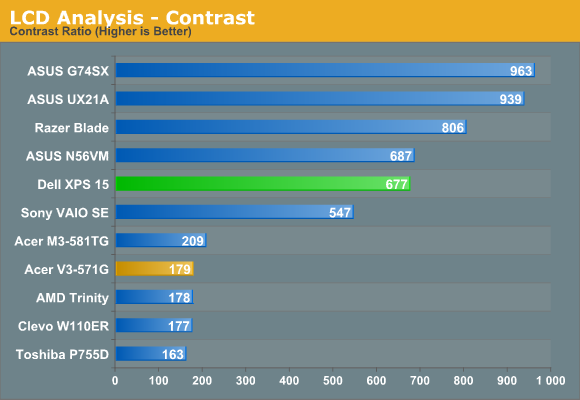
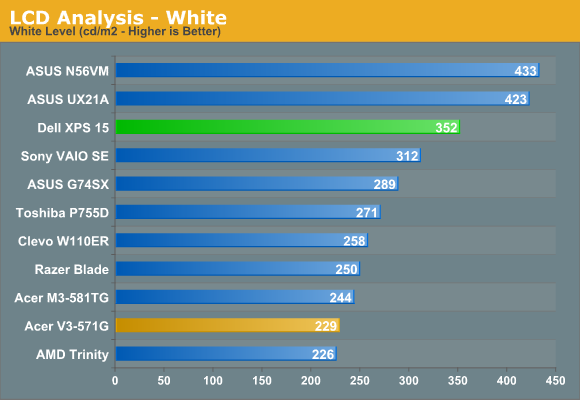
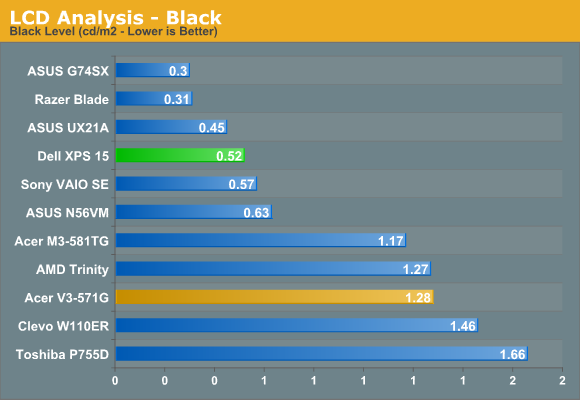
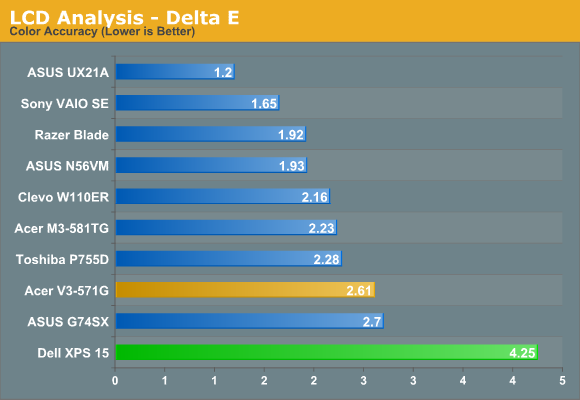
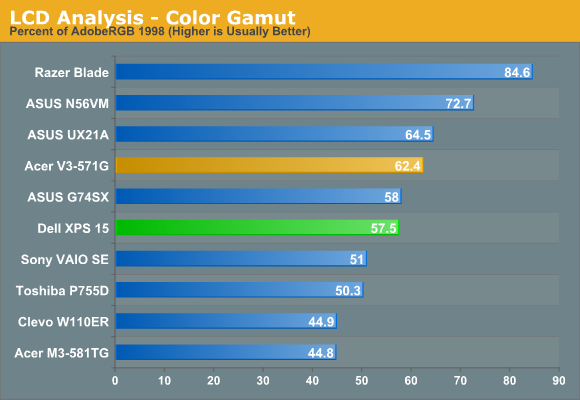
Contrast checks in at 677:1, which is better than average but not exceptional. The maximum white level is 350 nits, but that’s with a very strong blue component. Once you calibrate to remove that, the maximum white level drops substantially down to just 250 nits. If you prefer “cool” colors, the LCD will probably make you happy, but those who prefer natural or warmer colors will immediately notice something is off. As noted above, delta E even after calibration is quite poor—just like the XPS 15z. That would make sense, as the two models appear to use the same AU Optronics B156HW03 panel. Color gamut is likewise middling, at 57% of Adobe RGB.
The minor complaints with the panel continue when we look at viewing angles. I’ve seen some TN panels that do a lot better in terms of vertical viewing angles; this LCD isn’t one of those. Viewed from above or below, you get severe color shifting and loss of contrast. There’s still a decent viewing arc where the LCD looks good, but this is on the lower end of the 1080p LCDs that we’ve tested. I also noticed a fair amount of “shimmer” on the edges of windows when moving them around, which appears to come from the 6-bit to 8-bit color interpolation. That’s almost always present to varying degrees, but here it’s as noticeable as on lesser LCDs like that in the Acer V3-571G.
While the IPS panels in laptops like the UX21A, Sony VAIO SE, HP Envy 15, and Lenovo X220 aren’t perfect by any means, they’re still a substantial upgrade from panels like this—and this panel in turn is a substantial upgrade from the poor quality 1366x768 panes. We’d love to see more vendors push for IPS panels, and that goes double (triple even!) for high-end laptops like this XPS 15. If you’re paying under $1000 for a laptop, we understand the need to make some compromises, but ASUS has managed to get 1080p IPS displays into their new 11.6” and 13.3” Ultrabooks so there’s really no excuse for using a lower quality TN panel in a $1300+ laptop. And it almost goes without saying that Apple’s new 2880x1800 Retina MacBook Pro is in a league of its own.
















109 Comments
View All Comments
solipsism - Wednesday, July 25, 2012 - link
1) How is the experience with that large trackpad. So far I haven't seen or experienced any notebook following Apple's path here that has made it a great experience.2) Regarding the first page, I think the quality of the display is also very important. the MBP might be a TN panel but it's a damn good TN panel. Asus also has plenty of great panels in what tend to be cheap machines. Since I'm always looking at the display I couldn't choose this Dell even if the PPI is decent.
Spivonious - Wednesday, July 25, 2012 - link
147dpi is "decent"? My, how times have changed. I remember when I bought my 125dpi CRT and it was top-of-the-line.Still, since most Windows apps aren't high-DPI aware, getting a high DPI screen on a laptop isn't as important as it is on a phone or tablet.
Don't get me wrong, I do like the higher DPI screens that we're seeing now, but calling 147dpi "decent" really made me laugh.
solipsism - Wednesday, July 25, 2012 - link
It's not a measure of percentage over a set time frame. It's simply a statement of what is deemed satisfactory.Note that at 141 PPI it's significantly more than the MBP at 110 PPI. Note that you only need to be 24" away from the display for it to be Retina quality for those with 20/20 vision.
PS: Even though we now have 200 PPI displays with the new MBPs don't think that ten years from now that display will be crap if it's not 5, 10 or 20x the pixel density. Around 200 PPI will be hear for a very long time.
Serge SC - Thursday, September 13, 2012 - link
I've had a 15.6" FHD screen for 3 years now.My eyes are in the 18/20 perhaps, even better, and still, I can't see the pixels while being around 50 cm away from my screen...
Sure, the more the merrier, but at full HD on this size of panel, it is good enough that 90% of users can't see pixels from normal usage distance.
SodaAnt - Wednesday, July 25, 2012 - link
Well, I've had a 1080P 15" laptop display for a while, and to be honest, as long as you are sitting in a normal position about two feet away from the screen, there is no way you can see the individual pixels. However, I do admit that they have a long way to go on making the screen look good though.Frallan - Wednesday, July 25, 2012 - link
Hmm had they been able to squeeze a 660 in there it would have been an immediate buy for me but the 640 just doesn't cut it. It would be interestin to see some new development in heat management in lappys - the same theory and build is still being used as for 10 yrs. I think that it should be possible today to think of a new way of doing things.xype - Wednesday, July 25, 2012 - link
Don’t worry, as soon as Apple decides to use any of the myriad of advanced cooling solutions, everyone will start doing it. It’s just, you know, too big a RISK to try it first. Better have another medicore model selling in small numbers than try and aim for Gold.ananduser - Wednesday, July 25, 2012 - link
What was said about this model regarding thermals is also true about Apple's MBP. As soon as you start pushing the hardware it too gets extremely hot.xype - Wednesday, July 25, 2012 - link
That’s why I said "as soon as Apple decides", meaning "they are not doing it, yet." Duh.Spoony - Wednesday, July 25, 2012 - link
In the past, I would have agreed with you wholeheartedly. Previous MacBook Pros (and PowerBooks) were absolute space heaters. They sat at about 95C as soon as you started doing anything intensive with them. Lap toasters!The fan ramps used by Apple are also hugely conservative in favour of noise, which I do not feel is the right trade off. Frequently you'd see 103C before the fans had ramped up all the way.
All this being said, I recently ran several stress tests to see if the differences Apple had made to the Retina MacBook Pro actually did anything. The results were extremely positive. A highly synthetic stress test on CPU/GPU yielded 82C highest temp (on the Nvidia card).
I bought a rMBP, and have been very satisfied with the thermal performance. Coming from somebody who was highly critical of all previous Apple machines in this regard. You do have to encourage the fan to ramp properly sometimes, so it isn't perfect. Just a lot better.